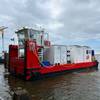The world and the American maritime industry have changed dramatically since one of America's darkest hours, World War II, when United Seamen's Service was born to aid exhausted, wounded and battle-traumatized merchant seafarers in faraway places and unsafe harbors.
It was 1942, 65 years ago, when President Franklin D. Roosevelt and the maritime unions and management recognized the need to provide havens and facilities in more than 125 worldwide locations for rest, recreation and safety for those seafarers who carried troops and war materials to ports in the war zones.
Today, while war zones still dot the world, technology has changed the way shipping does business. Small, run-down harbors where ships stayed in port for weeks at a time are today sprawling clean computer-run facilities where the vessels may turn around in less than a day. Nevertheless, USS services are still needed in the eight strategic locations where the mission is continued and the commitment to the fourth arm of defense remains a constant.
World War II's first casualties were merchant seafarers. Enemy submarines infested the oceans and American seafarers, as well as the military, were vulnerable. The armed forces had the USO and Military Service Clubs. Maritime unions voiced concerns about the urgent need for such facilities
for the merchant marine.
Admiral Emery S. Land of the War Shipping Administration recommended the concept of a USS to President Roosevelt in 1942 and on August 8 it became a reality. The country embraced USS. Henry Kaiser was its first president. First Lady Eleanor Roosevelt made frequent trips to USS centers, visiting seafarers and boosting morale. Actress Madeline Carroll, the Duke and Duchess of Windsor and George Jessel were among the long list of luminaries who devoted time and energy to a service they acknowledged as necessary.
The USS centers have always opened and closed as the need dictated by how the cargo moved. By 1947, domestic centers had closed but USS began providing facilities for tanker crews in Venezuela. Other worldwide centers opened during the war stayed open during peacetime as deemed necessary by seafarer activity. By 1950, the Korean War outbreak demanded the need for centers throughout Asia to serve vessels laden with munitions and supplies for the troops. At the same time, the Italian government offered rent-free space for a center in Naples and seven USS centers opened to service oil fields in the Middle East. The agency found itself growing and meeting needs in new venues.
In 1950, USS proved invaluable to the predecessor of today's Military Sealift Command-the Military Sea Transport Service (MSTS). Merchant seafarers make up the backbone of MSC because American ships are used to support U. S. armed forces abroad. In fact, they have delivered billions
of tons of cargo, assisted rescues at sea and also rescued refugees seeking freedom by escaping in treacherous waters.
To clarify jurisdictional parameters, USS sought and finally received documents from the Department of Defense stating its role and confirming its authority. Further efforts in Congress resulted in the Seamen's Service Act signed by President Richard Nixon in 1970.
In the decade of U. S. participation in the Vietnam War, centers opened in Cam Ranh Bay in 1965, Qui Nhon in 1967 and Newport-Saigon in 1971. As long as the areas were secure enough to permit merchant shipping, USS would stay open. In fact, USS personnel, including Roger Korner, were among the last to leave Saigon when that city fell in April 1975.
Today's USS celebrates its longevity in various parts of the world. The center in Casablanca has been operating for 55 years; Bremerhaven, Guam, Yokohama, Okinawa and Pusan are also all nearly 60 years old.
In addition, the American Merchant Marine Library Association, founded in 1921, became a USS affiliate in 1973 and has endeavored to make life at sea more entertaining by placing sea-going libraries on USNS, Ready Reserve Fleet, and MSC time chartered vessels. In 2006 alone, USS/AMMLA placed over 350 libraries on U.S. merchant vessels transporting supplies in support of U.S. Forces.
Subscribe for
Maritime Reporter E-News
Maritime Reporter E-News is the maritime industry's largest circulation and most authoritative ENews Service, delivered to your Email five times per week










